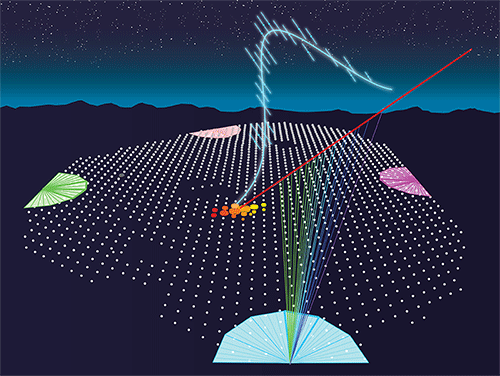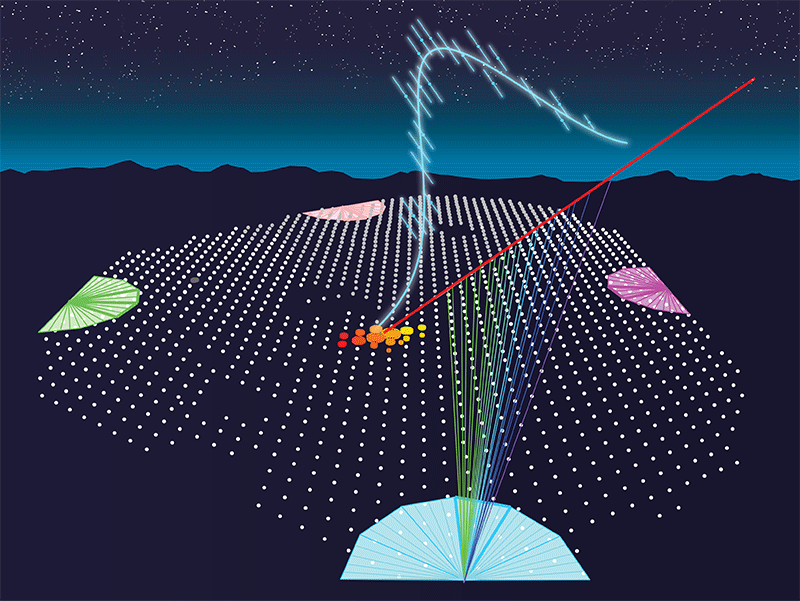Cosmic-Ray Showers Reveal Muon Mystery
The Large Hadron Collider at CERN produces proton collisions with center-of-mass energies that are 13 thousand times greater than the proton’s rest mass. At such extreme energies these collisions create many secondary particles, whose distribution in momentum and energy reveals how the particles interact with one another. A key question is whether the interactions determined at the LHC are the same at higher energies. Luckily, nature already provides such high-energy collisions—albeit at a much lower rate—in the form of cosmic rays entering our atmosphere. Using its giant array of particle detectors, the Pierre Auger Observatory in Argentina has found that more muons arrive on the ground from cosmic-ray showers than expected from models using LHC data as input [1]. The showers that the Auger collaboration analyzed come from atmospheric cosmic-ray collisions that are 10 times higher in energy than the collisions produced at the LHC. This result may therefore suggest that our understanding of hadronic interactions (that is, interactions between protons, neutrons, and mesons) from accelerator measurements is incomplete.
Cosmic rays are relativistic particles (mostly protons and light nuclei) that are produced by supernovae and other powerful sources in and beyond our galaxy. When a cosmic-ray particle collides with a molecule in Earth’s atmosphere, it generates a cascade of secondary particles. An incident proton, for example, will typically expend 40% of its energy producing a secondary proton or neutron, together with a large number of other hadrons, mostly pions. Neutral pions decay immediately to two photons that generate an electromagnetic “cascade” comprising electron-positron pairs and gamma rays. Charged pions with high energies interact again in the atmosphere. The neutral pions they produce contribute further to the electromagnetic component of the shower, while other particles carry energy forward to subsequent interactions. Lower-energy charged pions decay before interacting again and produce muons, which largely survive to the ground.
Unlike detectors at accelerators, experiments like Auger do not directly detect the initial collision but only the secondary cascade that it generates. This is simply because the rate of events is too low: At an energy equivalent to 10 times the center-of-mass energy at the LHC, the cosmic-ray flux is only about one particle per square kilometer per year. This is far too low to observe the collision directly with a detector in space or a balloon-borne detector above the atmosphere. Auger, with a detector array that spans 3000 square kilometers, may collect only a few thousand such events per year. In comparison, the LHC can produce a billion proton collisions per second.
Auger observes the first interaction indirectly by analyzing the shower of particles it generates [2]. To detect shower particles that reach the ground, the observatory uses 1660 water-filled tanks separated from each other by more than a kilometer. When struck by a high-speed particle, the water emits a flash of light (Cherenkov radiation). Auger complements the detection of particles on the ground by tracking the path of a cascade in the atmosphere with four telescopes, placed at the perimeter of the array, that are sensitive to the fluorescent light generated by the cascade (Fig. 1).
Events seen by both the fluorescence telescopes and the water tanks are called hybrid events. They constitute only a small fraction of all of the ground events because the fluorescence can only be observed on clear, moonless nights. However, they are a particularly valuable subsample because the fluorescence from the shower as a function of its penetration into the atmosphere—the shower profile—is sensitive to the mixture of nuclei in the primary cosmic radiation [3]. Also, because most of the muons arriving at the ground are from interactions involving charged pions, the ground signal is primarily sensitive to the properties of hadronic interactions. On the other hand, the atmospheric cascade probed by the telescope consists mostly of electrons and positrons descended from the first few hadronic interactions. It therefore reflects the primary particles’ energies. In their new analysis, the Auger collaboration uses a sample of 411 hybrid events, collected over nine years, in a narrow energy range of around eV.
For each hybrid event, the Auger researchers compare two quantities: the signal measured at the ground and the signal expected at the ground, which they compute with models that use parameters determined by the latest LHC measurements. A complication for these computations is that they depend on the identity of the nucleus involved in the first collision and on where in the atmosphere the shower starts and how it develops, all of which vary from shower to shower. To solve this problem, the Auger team simulates each event 25,000 times, on average, thereby sampling all the possibilities for how the different particle interactions are distributed in energy and in the atmosphere. They then pick several simulations that fit the telescope measurements well. From these “best fit” telescope measurements, they predict the signal on the ground using two models based on LHC data.
But there is an additional wrinkle. The signal at the ground comes both from muons and from the electrons and positrons produced by the electromagnetic cascade. Since these two components cannot be distinguished, the researchers must predict them separately. Fortunately, the electromagnetic component dominates for cascades arriving from straight above the observatory, while the muon component dominates for angles of arrival exceeding 37 degrees. (The data correspond to events with arrival angles from 0 to 60 degrees.) Taking account of this difference, the researchers scale the two components predicted by the models separately to obtain the best fit to the data. The scaling factor they get for the electromagnetic component is near unity, but it is between 1.3 and 1.6 for the hadronic component. In other words, Auger has detected about 30–60% more muons than expected.
This discrepancy has been seen before. In 2000, the HiRes-MIA hybrid array in Utah found a higher density of muons at 600 m from the shower’s trajectory than expected from (then current) models of hadronic interactions [4]. Last year, the problem showed up in the analysis of nearly horizontal showers at Auger [5]. The new results from Auger put the muon excess on a firmer basis by making a tight connection between the telescope measurements and the signal on the ground. This finding suggests that the best models of hadronic interactions are missing something. One possibility is that they do not account for a process that keeps more energy in the hadronic component; for example, a higher production of baryon-antibaryon pairs [6]. Another option is that the physics of strong interactions changes at energies beyond those tested at the LHC [7, 8].
What’s next? The Auger collaboration can extend its analysis outside the narrow energy range to look for an energy dependence of the discrepancy, which would provide a clue to its origin. For a complementary test, they could also analyze other observables that are sensitive to hadronic interactions, such as the height at which muons are produced. Finally, a significant upgrade called “Auger Prime” is underway [9]. This will allow the team to measure the muon and electromagnetic contributions to the ground signal separately, removing a significant source of uncertainty in their current analysis.
This research is published in Physical Review Letters.
References
- A. Aab et al. (Pierre Auger Collaboration), “Testing Hadronic Interactions at Ultrahigh Energies with Air Showers Measured by the Pierre Auger Observatory,” Phys. Rev. Lett. 117, 192001 (2016).
- A. Aab et al. (Pierre Auger Collaboration), “The Pierre Auger Cosmic Ray Observatory,” Nucl. Instrum. Methods Phys. Res., Sect. A 798, 172 (2015).
- A. Aab et al. (Pierre Auger Collaboration), “Depth of Maximum of Air-Shower Profiles at the Pierre Auger Observatory. II. Composition Implications,” Phys. Rev. D 90, 122006 (2014).
- T. Abu-Zayyad et al. (HiRes-MIA Collaboration), “Evidence for Changing of Cosmic Ray Composition between and eV from Multicomponent Measurements,” Phys. Rev. Lett. 84, 4276 (2000).
- A. Aab et al. (Pierre Auger Collaboration), “Muons in Air Showers at the Pierre Auger Observatory: Mean Number in Highly Inclined Events,” Phys. Rev. D 91, 032003 (2015).
- T. Pierog, “LHC Data and Extensive Air Showers,” EPJ Web Conf. 52, 03001 (2013).
- G. R. Farrar and J. D. Allen, “A New Physical Phenomenon in Ultra-High Energy Collisions,” EPJ Web Conf. 53, 07007 (2013).
- J. Alvarez-Muñiz, L. Cazon, R. Conceição, J. Dias de Deus, C. Pajares, and M. Pimenta, “Muon Production and String Percolation Effects in Cosmic Rays at the Highest Energies,” arXiv:1209.6474.
- A. Aab et al. (Pierre Auger Collaboration), “The Pierre Auger Observatory Upgrade – Preliminary Design Report,” arXiv:1604.03637.





